An Integrated Study of Economic, Energy, Defense, Social, and Technological Strategies Amidst the Fourth Turning, Omega Point, and Great Filter Scenarios
Abstract
This report examines the comparative strengths of the Conservative Party’s policy platform under Pierre Poilievre (2022 – 2025) versus the Liberal Party’s policies (2015 – 2025) (that have already been demonstrated in effect for a decade and serve as the default benchmark for our study), in addressing a turbulent global environment marked by provocative U.S. actions, notably during Trump’s administration, and by existential challenges including the “Fourth Turning,” the drive toward an “Omega Point” (or singularity), the “Great Filter” hypothesis, and colliding dystopias. Drawing on primary party documents, speeches, and reputable secondary sources (Reuters, Politico, Global News), the report synthesizes insights from both domestic policy and broader geopolitical threat assessments. It argues that the Conservative approach…
— emphasizing fiscal discipline, energy independence, robust national defense, controlled immigration, cultural cohesion, proactive trade diversification, and rapid technological innovation —
…is better suited to safeguard Canada’s sovereignty and long-term resilience.
The report concludes with strategic recommendations for Canadian policymakers and outlines a framework for future research in this critical area.

Table of Contents

1. Introduction
In an era of unprecedented change and global uncertainty, Canada finds itself at a critical crossroads. The legacy of aggressive U.S. policies under President Donald Trump…
— including provocative annexation rhetoric, economic tariffs, enhanced border security measures, and diplomatic strains —
…has not only reshaped North American relations but also intensified debates over national sovereignty and resilience.
Simultaneously, scholarly and strategic discourses such as the “Fourth Turning” (cyclical crisis theory), the concept of an “Omega Point” or singularity (reflecting rapid technological convergence), and the “Great Filter” (which postulates existential challenges that civilizations must overcome)frame our understanding of the multifaceted threats of the 21st century.
In this context, the Conservative Party of Canada under Pierre Poilievre (2022 – 2025) has articulated a policy platform that proponents argue is uniquely tailored to confront these challenges…
— by emphasizing fiscal discipline, resource independence, energy independence, robust national defence, manufacturing innovation and technological innovation —
…while the Liberal Party’s record (2015–2025) has been critiqued for its progressive spending, reliance on globalist alliances, and policies that may inadvertently weaken national resilience, weaken emergency response capabilities and weaken defence capabilities.
This report aims to comprehensively compare these policy platforms and assess their strategic viability in an environment defined by global economic competition, geopolitical subversion, and rapid technological transformation.
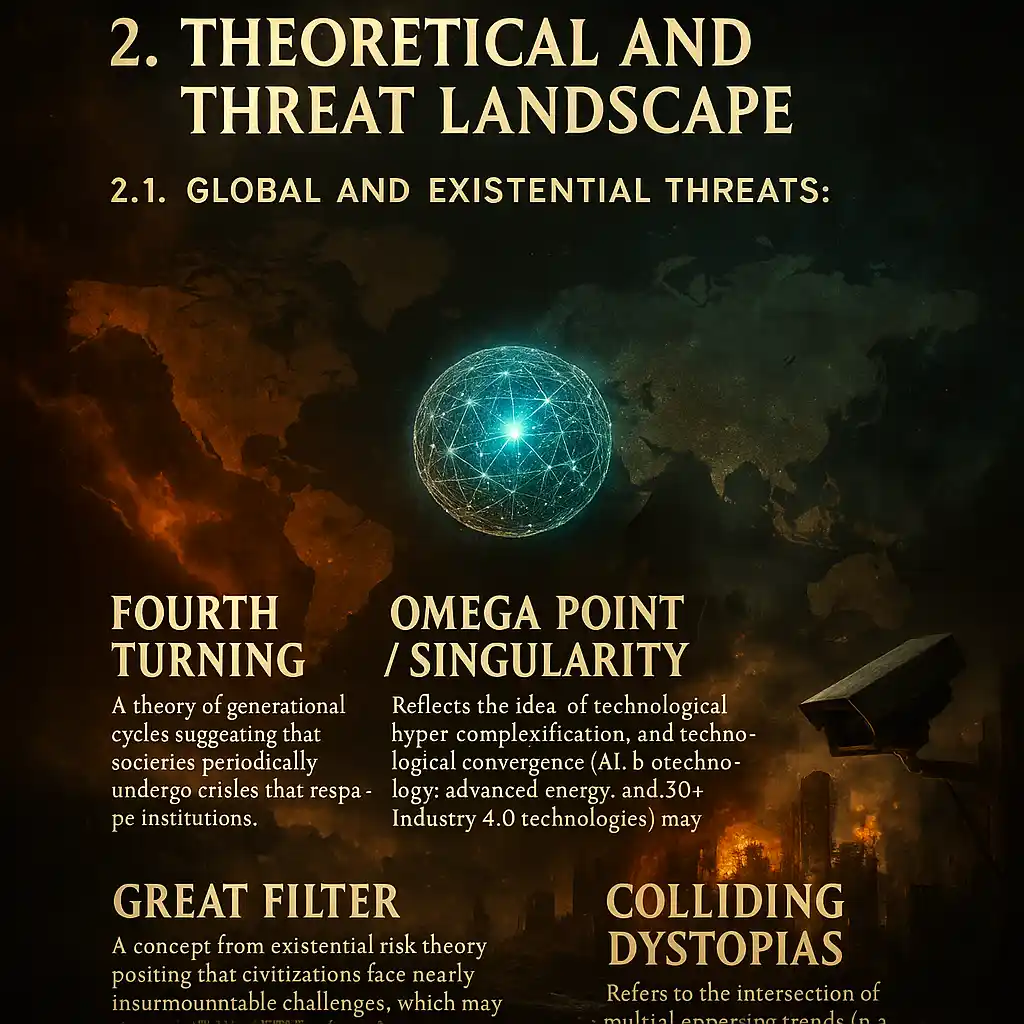
2. Theoretical and Threat Landscape
2.1. Global and Existential Threats:
-
Fourth Turning: A theory of generational cycles suggesting that societies periodically undergo crises that reshape institutions. Current evidence indicates that Western democracies are amid such a crisis, where economic, political, and social disruptions converge.
-
Omega Point / Singularity: Reflects the idea that technological hyper-complexification, and technological convergence (AI, biotechnology, advanced energy, and 30+ Industry 4.0 technologies) may eventually lead to a radical transformation of society. The drive toward an “Omega Point” suggests both immense opportunity and profound risk.
-
Great Filter: A concept from existential risk theory positing that civilizations face nearly insurmountable challenges, which may result in collapse if not managed effectively.
-
Colliding Dystopias: Refers to the intersection of multiple negative trends (e.g., climate change, surveillance, societal fragmentation) that could jointly lead to dystopian outcomes.
2.2. Trump’s Provocative U.S. Policy and Media Narratives
-
Aggressive U.S. Actions: Under Trump’s administration, actions such as annexation proposals and tariffs were seen as direct economic and geopolitical provocations against Canada. Media narratives around these actions have resonated strongly with Canadian audiences, often reinforcing the need for a policy platform that prioritizes sovereignty and self-reliance.
-
Media Distraction: The use of provocative rhetoric and policy measures by Trump not only created tensions but also diverted media focus, highlighting the importance of clear, strategic policy responses in Canada.
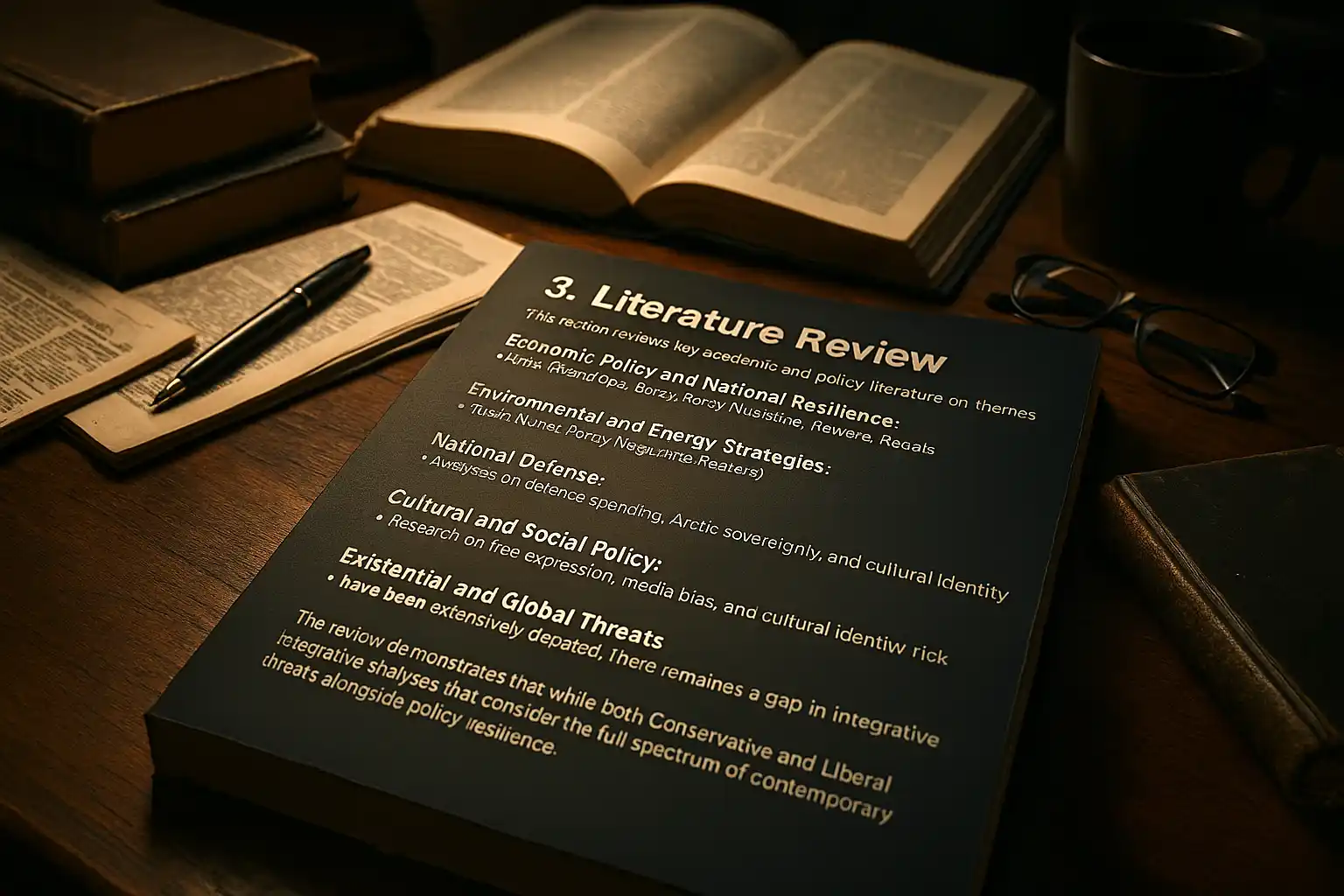
3. Literature Review
-
Economic Policy and National Resilience: Works from global policy institutes, think tanks, and news analyses (e.g., Global News, Policy Magazine, Reuters).
-
Environmental and Energy Strategies: Analyses on energy independence and industrial competitiveness, with reference to SMRs and renewable integration.
-
National Defense: Studies on defense spending, Arctic sovereignty, and countering foreign influence (including recent articles in The Walrus and Reuters).
-
Cultural and Social Policy: Research on free expression, media bias, and cultural identity in Canadian policy.
-
Existential and Global Threats: Academic theories such as the Fourth Turning (Strauss & Howe), singularity studies (Tegmark, Bostrom), and existential risk frameworks (Ord).

4. Methodology
4.1. Data Sources and Comparative Criteria
-
Primary Sources: Official policy documents, speeches, and public statements from Pierre Poilievre and his team (2022 – 2025). Government publications and Liberal Party records (2015 – 2025).
-
Secondary Sources: Reputable news outlets (Reuters, Politico, Global News). Policy analyses from think tanks and academic research on geopolitical cycles and existential risks.
-
Comparative Criteria: Economic Resilience: Fiscal discipline, tax policy, and innovation. Energy Independence: Domestic production, technological investments (e.g., SMRs). National Defense: Defense spending, strategic initiatives (e.g., Arctic sovereignty). Immigration and Border Security: Balance between economic utility and public safety. Social and Cultural Cohesion: Policies on free expression, media regulation, and cultural identity. Foreign Policy and Trade Diversification: Approaches to sovereignty and global alliances. Technological Innovation: Digital modernization and emerging economic sectors.
4.2. Analytical Framework
-
Qualitative Analysis: Content analysis of speeches and policy documents.
-
Comparative Case Study: Cross-thematic comparisons to identify strengths and weaknesses.
-
Theoretical Integration: Using concepts like the Fourth Turning, Omega Point, Great Filter and Colliding Dystopias (may be different combinations of dystopias for different regions), to contextualize policy effectiveness in an existential risk framework.
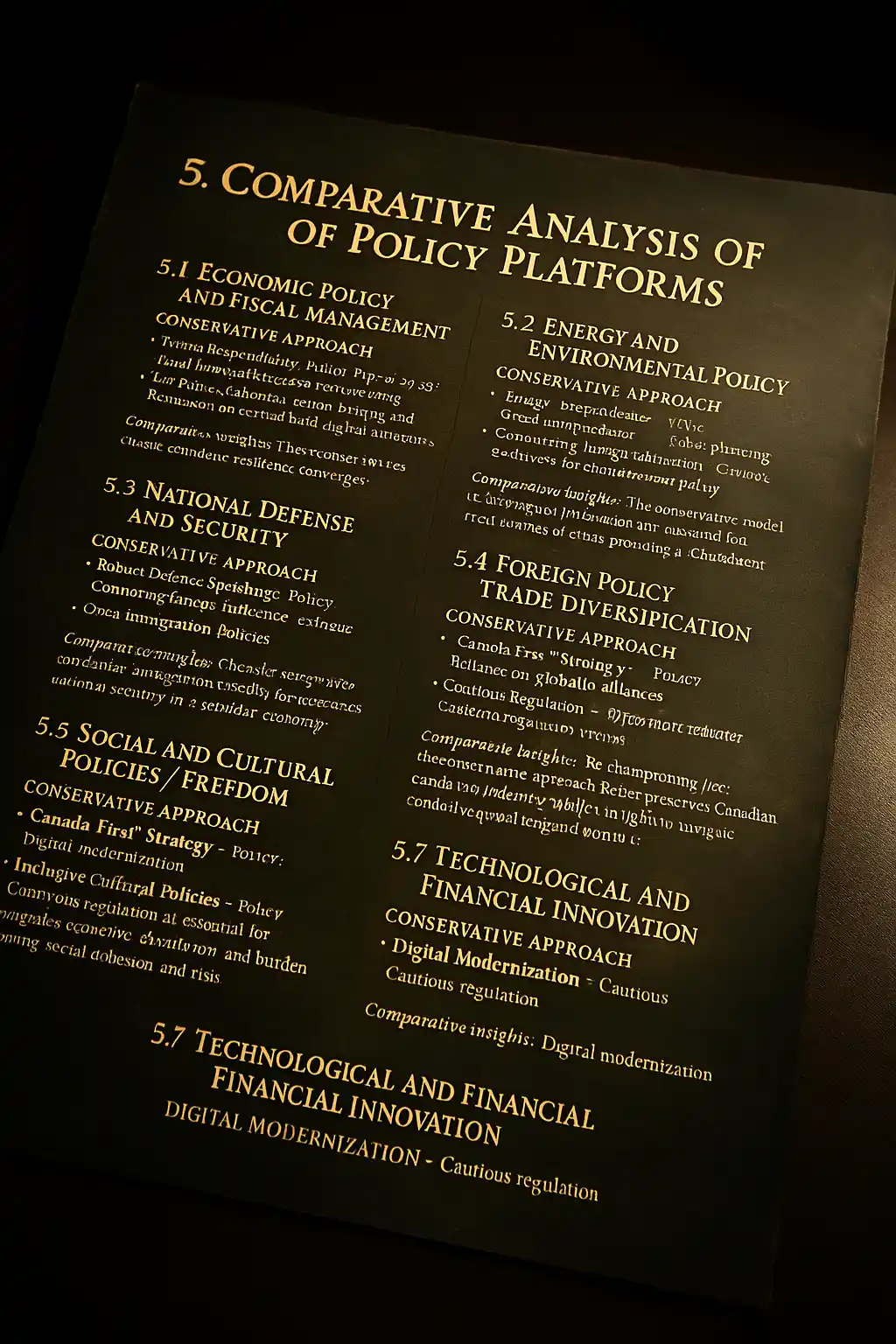
5. Comparative Analysis of Policy Platforms
5.1. Economic Policy and Fiscal Management
Conservative Approach (2022 – 2025)
-
Fiscal Responsibility: Policy: “Pay-as-you-go” laws requiring new spending to be offset by cuts, rigorous audits of the Bank of Canada, and a prohibition on central bank digital currencies. Rationale: Reducing deficits and national debt is crucial amid global economic instability and rise in private currencies that are competitive on efficiency basis.
-
Tax Policy: Policy: Lowering personal and corporate taxes and repealing the federal carbon tax. Rationale: Stimulates economic growth, keeps living costs low, and enhances competitiveness.
-
Financial Innovation:Policy: Support for blockchain and cryptocurrency regulation to position Canada as a leader in digital finance. The USA is leading the way here, and might absorb Canada’s wealth soon. Rationale: A modern regulatory environment attracts investment, mitigates dependence on traditional financial systems and reduces wealth transfer risks from Canada to USA/Fed System using XRP and/or Hashgraph and/or Ethereum and/or Bitcoin and/or Cardano.
-
Trade Diversification: Policy: Expand trade relations beyond the U.S. and remove inter-provincial trade barriers. Rationale: Reduces vulnerability to U.S. protectionism and builds a robust internal market.
Liberal Approach (2015 – 2025)
-
Progressive Fiscal Stimulus: Policy: High government spending on social programs, infrastructure, and climate initiatives [while ignoring global carbon impact of adding individuals from low carbon economies (self sustaining farmers), to high carbon economy output Canada]. Critique: Critics argue that this has led to higher deficits, massive debts in the system from high population levels and high administrative growth rates due to increasing population levels, and increased foreign capital reliance.
-
Carbon Taxation and Progressive Taxation: Policy: Implementation and expansion of carbon taxes and progressive tax policies. Critique: While intended to foster environmental sustainability, these measures may stifle economic dynamism and burden households.
5.2. Energy and Environmental Policy
Conservative Approach
-
Energy Independence: Policy: Pursuit of aggressive pipeline projects, increased domestic energy production, and support for Small Modular Reactors (SMRs). Rationale: Ensures national security and economic stability by reducing reliance on foreign energy imports.
-
Technological Solutions for Climate: Policy: Invest in green technology such as carbon capture and advanced battery technologies without imposing heavy carbon taxes. Rationale: Balances environmental stewardship with industrial competitiveness.
Liberal Approach
-
Green Energy and Carbon Pricing: Policy: Emphasis on renewable energy mandates and carbon taxes as drivers for environmental policy. Critique: High carbon costs might undermine energy security and industrial strength.
5.3. National Defense and Security
Conservative Approach
-
Robust Defense Spending: Policy: Modernize the Canadian Armed Forces, establish military bases in strategic locations (e.g., the Arctic), and double the number of Inuit rangers. Rationale: A strong, independent military is vital to counter conventional and hybrid threats from adversaries like Russia, the CCP, and transnational criminal networks.
-
Countering Foreign Influence: Policy: Create a foreign agents registry and reallocate foreign aid toward domestic defense initiatives. Rationale: Enhances transparency and protects against covert foreign subversion.
Liberal Approach
-
Diplomatic and Multilateral Defense: Policy: Rely on traditional alliances and multilateral diplomacy with less aggressive defense spending. Critique: May not provide sufficient deterrence or rapid response in times of escalating hybrid or existential threats.
5.4. Immigration and Border Security
Conservative Approach
-
Controlled Economic Immigration: Policy: Streamline credential recognition for skilled immigrants and enforce strict border security measures. Rationale: Balances economic growth with national security imperatives.
Liberal Approach
-
Open Immigration Policies: Policy: Emphasis on multiculturalism and more lenient border regulations. Critique: Critics contend that these policies may weaken border security and strain public resources during crises.
5.5. Social and Cultural Policies / Freedom of Expression
Conservative Approach
-
Defending Free Expression: Policy: Repeal restrictive legislation (e.g., Bill C-11) and reduce federal funding for public broadcasters perceived as biased. Rationale: Ensures a broader spectrum of Canadian voices — from urban intellectuals to rural, down-to-earth communities — is represented.
Liberal Approach
-
Inclusive Cultural Policies: Policy: Emphasis on multiculturalism and progressive social values and funding to Liberal minded media outlets. Critique: Sometimes seen as catering predominantly to urban elites, potentially alienating traditional or grassroots constituencies.
5.6. Foreign Policy and Trade Diversification
Conservative Approach
-
“Canada First” Strategy: Policy: Diversify trade relationships beyond the U.S. and assert sovereignty by responding robustly to external economic pressures (e.g., tariffs). Rationale: Minimizes dependency on any single partner and strengthens political independence.
Liberal Approach
-
Reliance on Globalist Alliances: Policy: Continued dependence on established multilateral institutions and traditional alliances. Critique: May leave Canada vulnerable to external shifts and less agile in responding to emerging threats.
5.7. Technological and Financial Innovation
Conservative Approach
-
Digital Modernization: Policy: Aggressively support blockchain technology, cryptocurrency, and other digital innovations to modernize the Canadian economy. Rationale: Fosters a dynamic, future-proof economy capable of adapting to rapid technological change.
Liberal Approach
-
Cautious Regulation: Policy: Implement tighter regulatory frameworks intended to protect consumers in digital spaces and/or censorship, hate speech laws, red flag laws, yellow flag laws, court Judge bypass laws. Critique: This can slow innovation and reduce Canada’s competitive edge in emerging sectors.
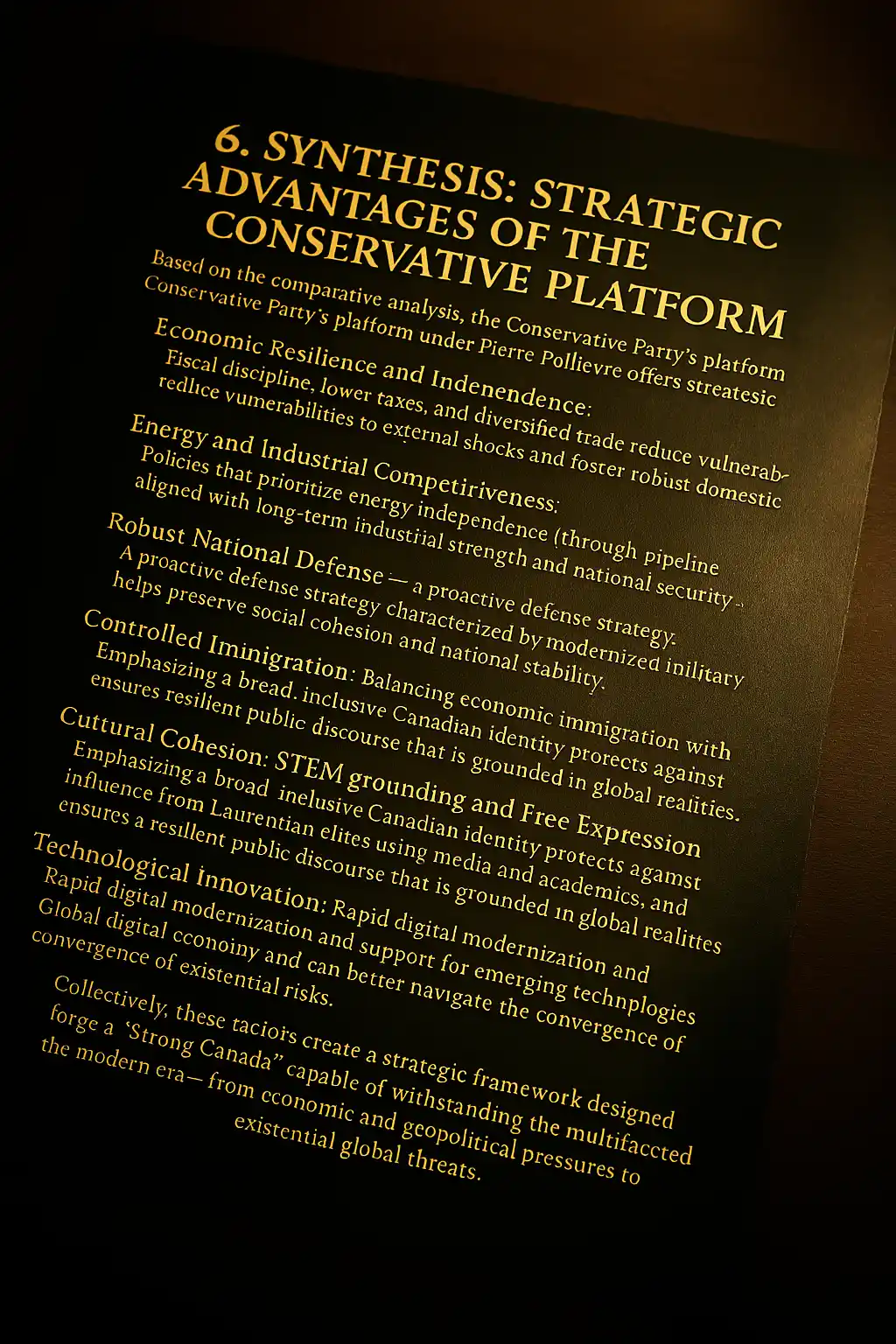
6. Synthesis: Strategic Advantages of the Conservative Platform
-
Economic Resilience and Independence: Fiscal discipline, lower taxes, and diversified trade reduce vulnerabilities to external shocks and foster robust domestic markets.
-
Energy and Industrial Competitiveness: Policies that prioritize energy independence (through pipeline projects, LNG terminals, materials mining, and SMRs) are better aligned with long-term industrial strength and national security.
-
Robust National Defense: A proactive defense strategy — characterized by modernized military spending, Arctic sovereignty, and countering foreign influence — positions Canada to repel hybrid threats.
-
Controlled Immigration: Balancing economic immigration with stringent border security helps preserve social cohesion and national stability.
-
Cultural Cohesion, STEM grounding and Free Expression: Emphasizing a broad, inclusive Canadian identity protects against cultural fragmentation, influence from Laurentian elites using media and academics, and ensures a resilient public discourse that is grounded in global realities, common sense, engineer’s builder’s philosophy, truth, real world physics and the complete STEM measure-able and analytical system of evaluation and progress.
-
Proactive Foreign Policy: A “Canada First” approach that diversifies trade and asserts independence shields Canada from over-reliance on external alliances.
-
Technological Innovation: Rapid digital modernization and support for emerging technologies ensure that Canada remains competitive in the global digital economy and can better navigate the convergence of existential risks.
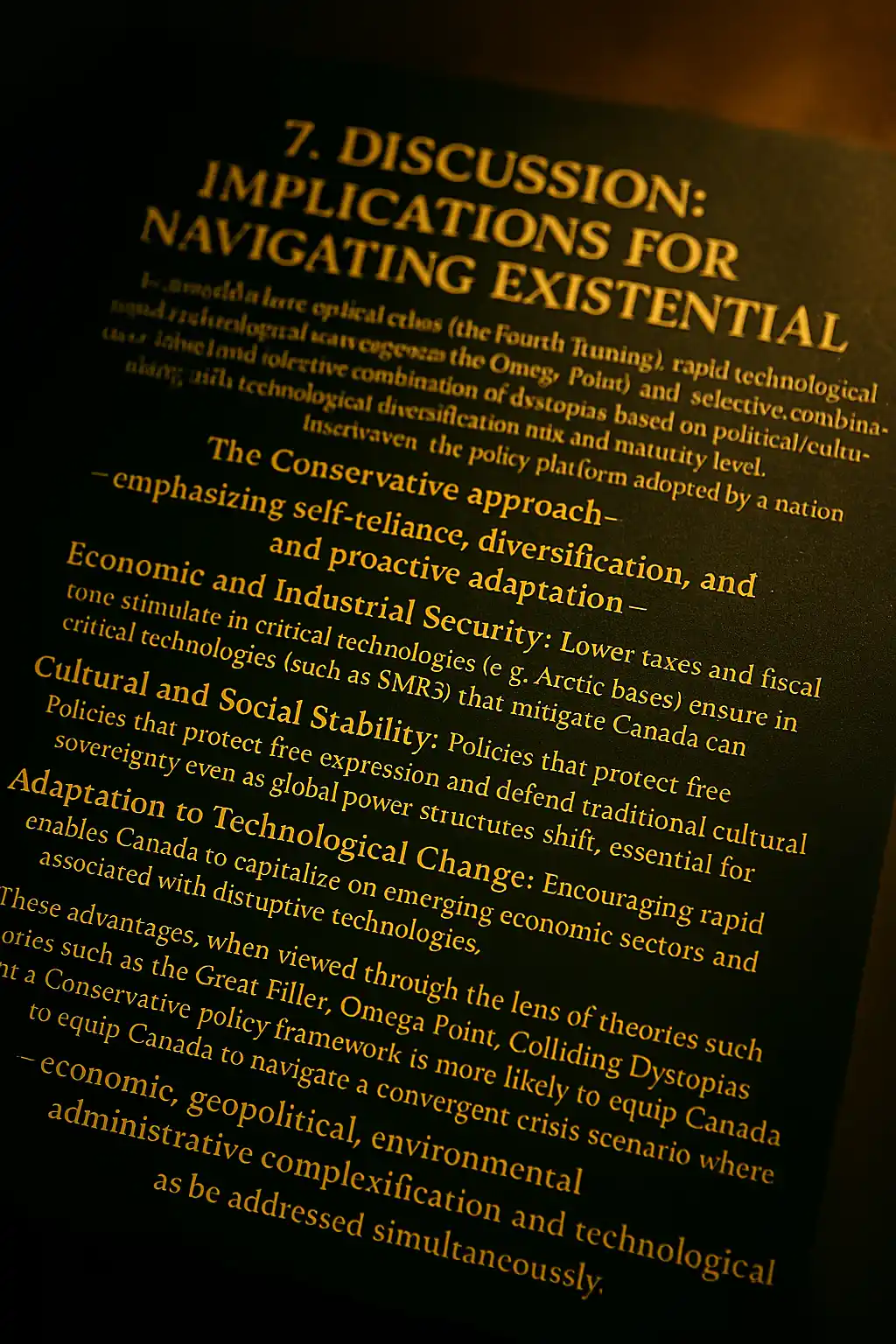
7. Discussion: Implications for Navigating Existential Crises
In a world where cyclical crises (the Fourth Turning), rapid technological convergence (the Omega Point), and existential risks (the Great Filter) and selective combination of dystopias based on political/cultural economic predispositions of a culture along with technological diversification mix and maturity level (Colliding Dystopias), are increasingly interwoven, the policy platform adopted by a nation becomes a matter of survival.
The Conservative approach…
— emphasizing self-reliance, diversification, and proactive adaptation —
…is argued to offer the following key advantages:
-
Economic and Industrial Security: Lower taxes and fiscal discipline not only stimulate growth but also provide the financial foundation necessary for investing in critical technologies (such as SMRs) that mitigate energy vulnerabilities.
-
National Defense in an Uncertain World: Enhanced military capabilities and strategic initiatives (e.g., Arctic bases) ensure that Canada can defend its sovereignty even as global power structures shift.
-
Cultural and Social Stability: Policies that protect free expression and defend traditional cultural identities help build a resilient social fabric, essential for withstanding periods of rapid change and potential societal fragmentation.
-
Adaptation to Technological Change: Encouraging rapid innovation and digital modernization enables Canada to capitalize on emerging economic sectors and mitigate risks associated with disruptive technologies.
These advantages, when viewed through the lens of theories such as the Great Filter, Omega Point, Colliding Dystopias and the Fourth Turning, suggest that a Conservative policy framework is more likely to equip Canada to navigate a convergent crisis scenario where multiple threats…
— economic, geopolitical, environmental, administrative complexificagiton and technological —
…must be addressed simultaneously.

8. Conclusion and Policy Recommendations
In conclusion, this report has offered a comprehensive, multi-dimensional analysis of the contrasting policy platforms of the Conservative Party under Pierre Poilievre (2022 – 2025) and the Liberal Party’s operating baseline and approach so far, as an average policy assessment over a decade long time period, sufficient sample size (2015 – 2025).
Summary of Findings
Economic Resilience and Independence:
The Conservative emphasis on fiscal discipline through “pay-as-you-go” measures, lower taxes, and strategic financial innovation fosters an economic environment resilient to global shocks.
By diversifying trade — both internationally and inter-provincially — Canada can reduce its vulnerability to U.S. protectionist policies and external economic pressures.
In contrast, the Liberal model, with its high spending and carbon taxation, risks generating higher deficits and over-dependence on foreign capital.
Energy and Industrial Competitiveness:
A central pillar of the Conservative strategy is the pursuit of energy independence. The aggressive development of domestic energy sources…
— bolstered by investments in pipelines, LNG, and Small Modular Reactors (SMRs) —
…provides a pragmatic route to reduce reliance on foreign imports while maintaining industrial competitiveness.
The Liberal focus on renewable energy and carbon pricing, although environmentally commendable, may impose burdens that weaken Canada’s industrial base in the face of global instability.
National Defense and Security:
Immigration and Border Security:
Social and Cultural Cohesion:
Defending free expression and preserving a broad, inclusive Canadian identity are cornerstones of the Conservative platform. These measures are designed to counteract the potential cultural fragmentation that may arise in times of rapid change.
In doing so, they safeguard a resilient public discourse that represents the full spectrum of Canadian society…
Foreign Policy and Trade Diversification:
The “Canada First” strategy advocated by Conservatives focuses on reducing dependency on a single economic partner
— primarily the United States —
…by actively diversifying trade relationships.
This independent and proactive foreign policy is particularly valuable in a global environment where geopolitical shifts and unilateral actions can threaten national sovereignty.
Technological and Financial Innovation:
In a rapidly evolving digital age, the Conservative commitment to aggressive digital modernization…
— supporting blockchain, cryptocurrency, and emerging technological sectors —
…ensures that Canada remains competitive on the global stage.
This nimble, innovation-friendly approach is vital for mitigating risks associated with technological convergence and for seizing new economic opportunities in a post-singularity world.
Implications for Navigating Existential Crises
The convergence of challenges…
— ranging from economic disruptions and geopolitical tensions to environmental crises and rapid technological change —
…demands a policy framework that is both resilient and adaptive.
The Conservative platform, with its integrated emphasis on economic self-reliance, energy independence, robust national defense, controlled immigration, cultural cohesion, and proactive trade and technological strategies, provides a blueprint for navigating these multifaceted risks. The theoretical lenses of the Fourth Turning, Omega Point, Colliding Dystopias and Great Filter further underscore the urgency for policies that not only manage current pressures but also anticipate future crises.
By building a “Strong Canada” through strategic diversification and self-reliance, the nation can better withstand external shocks and internal challenges.
The approach outlined here emphasizes a balanced mix of immediate tactical responses and long-term visionary planning…
— a necessary duality in an era where rapid change and convergent existential risks are the new normal.
Policy Recommendations
-
Enhance Fiscal Discipline: Enforce robust “pay-as-you-go” measures and streamline taxation policies to build a stable, resilient economic foundation.
-
Prioritize Energy Independence: Accelerate investments in domestic energy projects — including pipelines, LNG infrastructure, and SMRs — to ensure Canada’s industrial competitiveness and national security.
-
Strengthen National Defense: Increase defense spending and modernize military capabilities, particularly in strategic regions like the Arctic, while establishing mechanisms (e.g., foreign agents registry) to counter external subversion.
-
Balance Immigration and Border Security (Adjust to account for surplus immigration numbers from 2015 to 2025 and return to historical trends) Maintain a welcoming, skills-focused immigration system while ensuring a measured, sustainable approach that aligns with Canada’s economic and infrastructural capacity. Given the unprecedented surge in immigration between 2015 and 2025, a temporary reduction below historical immigration levels may be necessary for a transitional period of ten years to stabilize population growth and prevent persistent surpluses beyond Canada’s ability to integrate newcomers effectively. This approach will help restore balance, ensuring immigration levels remain sustainable, economically beneficial, and aligned with national capacity growth and historical and current growth rates and growth trend line/industrial growth rates (Ex: electrification generation growth gate is only 0.5% per year, the real 21st century infrastructure index).
-
Foster Cultural and Digital Innovation: Protect free expression and promote diverse cultural representation alongside aggressive digital modernization to maintain Canada’s competitive edge.
-
Adopt a “Canada First” Trade Strategy: Diversify trade relationships and assert Canada’s economic independence through proactive foreign policy measures.
-
Invest in Technological Innovation: Encourage rapid adoption of emerging technologies, supporting a regulatory environment that minimizes bureaucratic delays and accelerates economic transformation.
Final Thoughts

9. References
-
Politico.com – For analyses on U.S. tariffs and trade diversification.
-
Reuters.com – For discussions on energy infrastructure and Arctic defense initiatives.
-
Global News, Policy Alternatives, Policy Magazine – For economic and environmental policy commentaries.
-
-
Academic literature on the Fourth Turning (Strauss & Howe), the Omega Point and singularity (Tegmark, Bostrom), and existential risk (Ord).
-
Additional reports and think tank analyses referenced throughout the study.
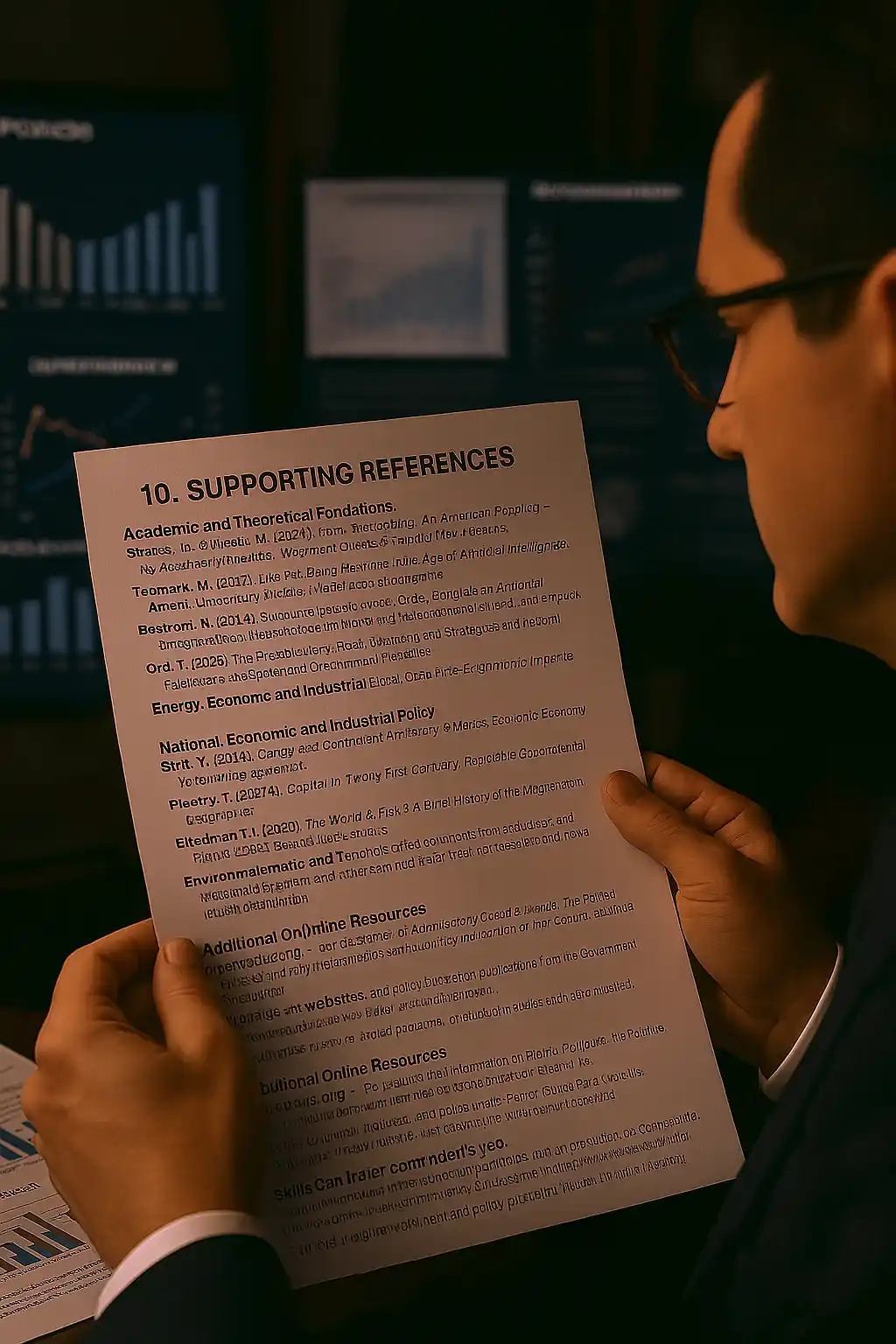
10. Supporting References
-
Strauss, N., & Howe, W. (1997). The Fourth Turning: An American Prophecy – What the Cycles of History Tell Us About America’s Next Rendezvous with Destiny. Broadway Books. (Provides the generational cycle framework used to interpret periods of crisis and renewal.)
-
Tegmark, M. (2017). Life 3.0: Being Human in the Age of Artificial Intelligence. Alfred A. Knopf. (Explores the implications of rapid technological convergence and the potential for a singularity.)
-
Bostrom, N. (2014). Superintelligence: Paths, Dangers, Strategies. Oxford University Press. (Examines risks related to artificial intelligence and its transformative impact on society.)
-
Ord, T. (2020). The Precipice: Existential Risk and the Future of Humanity. Hachette Books. (Discusses the concept of existential risks and the “Great Filter” that civilizations must overcome.)
-
Fukuyama, F. (1992). The End of History and the Last Man. Free Press. (Analyzes the ideological evolution of post-Cold War societies and its implications for national policy.)
-
Christensen, C. M. (1997). The Innovator’s Dilemma: When New Technologies Cause Great Firms to Fail. Harvard Business Review Press. (Provides insights into technological disruption and innovation strategies.)
-
Lessig, L. (2004). Free Culture: How Big Media Uses Technology and the Law to Lock Down Culture and Control Creativity. Penguin Press. (Explores the impact of technology on cultural expression and intellectual property.)
-
Smil, V. (2017). Energy and Civilization: A History. MIT Press. (Offers a comprehensive overview of energy transitions and their impact on economic development.)
-
Piketty, T. (2014). Capital in the Twenty-First Century. Harvard University Press. (Analyzes economic inequality and fiscal policy in modern economies.)
-
Friedman, T. L. (2005). The World Is Flat: A Brief History of the Twenty-First Century. Farrar, Straus and Giroux. (Discusses global economic integration and trade diversification.)
-
Chomsky, N., & Herman, E. S. (1988). Manufacturing Consent: The Political Economy of the Mass Media. Pantheon Books. (Examines media influence on public policy and geopolitical narratives.)
-
Global News, Reuters, Politico, and The Walrus articles (Reputable news outlets providing ongoing analyses of U.S.-Canada relations, defense spending, and energy initiatives.)
-
Relevant articles from Policy Alternatives and Policy Magazine (Provide critical assessments of fiscal, energy, and defense policies in Canada.)
-
Wallace-Wells, D. (2019). The Uninhabitable Earth: Life After Warming. Tim Duggan Books. (Highlights the potential impacts of climate change and environmental degradation.)
-
Putnam, R. D. (2000). Bowling Alone: The Collapse and Revival of American Community. Simon & Schuster. (Explores social cohesion and the challenges of modern community life.)
-
Carr, N. (2011). The Shallows: What the Internet Is Doing to Our Brains. W. W. Norton & Company. (Analyzes the impact of digital technology on public discourse and cognitive function.)
-
Additional relevant works and think tank reports (e.g., from the Institute for Research on Public Policy, the Fraser Institute, and the C.D. Howe Institute) (These provide context on Canadian fiscal policy, energy strategies, and defense expenditures.)
-
En.wikipedia.org – For background information on Pierre Poilievre, the Conservative Party platform, and key theoretical concepts such as the Great Filter.
-
Official government websites and policy publications from the Government of Canada – For up-to-date statistics and policy documents.
-
Skills Gap Trainer Communications website and related media (YouTube, Twitter/X) – For further insights, interviews, and supplementary data curated by SGT.

11. Appendices
Appendix A: Detailed Policy Comparisons (Bullet Points)
1. Economic Policy and Fiscal Management
Conservative Approach (2020 – 2025):
-
Fiscal Discipline: “Pay-as-you-go” laws that require new spending to be offset by cuts. Rigorous audits of institutions like the Bank of Canada.
-
Tax Policy: Lower personal and corporate taxes. Repeal of the federal carbon tax to reduce living costs.
-
Financial Innovation: Promotion of blockchain and cryptocurrency regulatory frameworks.
-
Trade Diversification: Expansion of trade relationships beyond the U.S. Removal of inter-provincial trade barriers to build a robust domestic market.
Liberal Approach (2015 – 2025):
-
Progressive Fiscal Stimulus: High levels of government spending on social programs, infrastructure, and climate initiatives.
-
Taxation and Carbon Pricing: Implementation and expansion of carbon taxes and progressive taxation.
-
Critiques: Increased deficits and reliance on foreign capital. Potential economic burdens on households and businesses.
Comparative Insight:
-
Conservatives argue that fiscal discipline and low taxes foster long-term economic resilience, while liberal spending may compromise economic independence during crises.
2. Energy and Environmental Policy
Conservative Approach:
-
Energy Independence: Aggressive pursuit of pipeline projects and domestic energy production. Strong support for Small Modular Reactors (SMRs) to reduce reliance on imports.
-
Technological Innovation: Investment in advanced green technologies (e.g., carbon capture, advanced battery storage) without heavy carbon taxes.
Liberal Approach:
-
Green Energy Focus: Emphasis on renewable energy mandates and carbon pricing.
-
Critiques: High carbon taxes may undermine energy security and industrial competitiveness.
Comparative Insight:
-
Conservatives emphasize pragmatic, technology-driven solutions to achieve energy independence and industrial competitiveness, while liberals prioritize environmental mandates that may impose high costs.
3. National Defense and Security
Conservative Approach:
-
Robust Defense Spending: Modernization of the Canadian Armed Forces. Establishment of strategic military bases (e.g., in the Arctic) and doubling Inuit ranger numbers.
-
Countering Foreign Influence: Creation of a foreign agents registry. Reallocation of foreign aid toward domestic defense.
Liberal Approach:
-
Diplomatic Defense: Focus on multilateral diplomacy and traditional alliances.
-
Critiques: Potential under-investment in rapid, proactive defense measures.
Comparative Insight:
-
Conservatives favour a proactive, robust defense posture to counter emerging threats, while liberals rely on multi-lateral strategies that may not address urgent, hybrid challenges.
4. Immigration and Border Security
Conservative Approach:
-
Controlled Immigration: Streamlined credential recognition for skilled immigrants. Strict enforcement of border security measures.
-
Rationale: Balances economic growth with national security.
Liberal Approach:
-
Open Immigration Policies: Emphasis on multiculturalism and inclusive immigration.
-
Critiques: Risks of straining public resources and compromising security during crises.
Comparative Insight:
-
Conservatives advocate for a balanced approach that maximizes economic benefits while ensuring strict border control; liberals prioritize openness, which may present security challenges.
5. Social, Cultural, and Freedom of Expression Policies
Conservative Approach:
-
Defending Free Expression: Repeal of restrictive legislation (e.g., Bill C-11). Proposal to reduce federal funding for public broadcasters seen as biased.
-
Cultural Identity: Emphasis on preserving a down-to-earth, inclusive Canadian identity that represents both urban and rural perspectives.
Liberal Approach:
-
Progressive Cultural Policies: Emphasis on multiculturalism and progressive social values.
-
Critiques: May lean toward elite urban perspectives, potentially alienating traditional or grassroots communities.
Comparative Insight:
-
Conservatives argue that their approach better protects a balanced and resilient cultural identity, which is crucial for social cohesion during periods of rapid change.
6. Foreign Policy and Trade Diversification
Conservative Approach:
-
“Canada First” Strategy: Proactive diversification of trade partners to reduce dependency on the U.S. Assertive response to external pressures such as tariffs.
Liberal Approach:
-
Globalist Alliances: Continued reliance on established multilateral institutions and traditional alliances.
-
Critiques: Potential over-dependence on external factors, reducing agility in responding to sudden shifts.
Comparative Insight:
-
Conservatives contend that a diversified, independent trade strategy strengthens political sovereignty and economic resilience, while liberal reliance on global alliances may leave Canada vulnerable.
7. Technological and Financial Innovation
Conservative Approach:
-
Digital Modernization: Aggressive support for blockchain, cryptocurrency, and other digital innovations. Aim to create a dynamic, future-proof economy.
Liberal Approach:
-
Cautious Regulation: Implementation of tighter regulatory frameworks to protect consumers.
-
Critiques: May slow down innovation and reduce competitive agility.
Comparative Insight:
-
Conservatives maintain that rapid technological adoption is essential for staying ahead in a post-singularity world, whereas liberal regulations could hamper progress and diminish Canada’s global competitiveness.
Appendix B: Supplementary Articles on Economic and Energy Metrics
1. “The Carbon Tax as a Foundational Barrier to Canada’s Prosperity and Sovereignty”
- URL: https://skillsgaptrainer.com/the-carbon-tax-as-a-foundational-barrier/
- Summary: This article examines how carbon tax policies can impede economic growth and distort energy pricing, arguing that such taxes may burden households and industries, thereby undermining national competitiveness.
- Relevance: It provides data and metrics on the economic impact of carbon taxes, supporting our analysis of energy policy effectiveness and fiscal discipline.
2. “Strengthening Canada’s Energy Exports from Coast to Coast: How Canada’s Oil & LNG Infrastructure Can Mitigate Hyperinflation Risks”
- URL: https://skillsgaptrainer.com/strengthening-canadas-energy-exports/
- Summary: This piece discusses the strategic importance of Canada’s oil and LNG infrastructure, outlining how a robust energy export framework can stabilize the economy and mitigate inflationary pressures in a volatile global market.
- Relevance: The article offers economic metrics and projections related to energy exports, which are essential for evaluating Canada’s industrial competitiveness and energy independence.
3. “Unlocking Canada’s Crown Lands: A Path to Economic Revival and National Prosperity”
- URL: https://skillsgaptrainer.com/unlocking-canadas-crown-lands/
- Summary: This resource explores how reforming Crown land policies can unleash economic potential by facilitating investments in energy, housing, and infrastructure.
- Relevance: It provides insights into natural resource management and its impact on economic metrics, highlighting the link between land policy and broader energy and industrial growth.
4. “Critique of the 15-Minute City Model: A Call for Practicality, Sustainability, and Security”
-
Summary: This article analyzes the limitations of high-density urban models, discussing their implications for energy consumption, sustainability, and overall economic efficiency.
-
Relevance: It offers comparative insights into energy efficiency metrics and sustainable urban planning — key factors in understanding Canada’s energy challenges and infrastructure needs.
5. “The Great Convergence: Resisting the Digital Authoritarianism & Centralized Control of Smart Cities”
- URL: https://skillsgaptrainer.com/the-great-convergence/
- Summary: Focusing on the interplay between digital innovation, economic metrics, and energy usage, this article highlights how modern technologies can both support and undermine sustainable urban growth.
- Relevance: It provides a data-driven perspective on how digital transformation influences energy and economic resilience, complementing the broader discussion on technological innovation.
Appendix C: Supplementary Media Coverage on Trump’s U.S. Actions and Canadian Responses
1. “After 150 Years of Friendship, the U.S. and Canada Come to Blows”
- Source: The Wall Street Journal
- URL: WSJ Article
- Summary: This article details the escalation of tensions between the United States and Canada, highlighting provocative moves by President Trump — including aggressive tariff proposals and inflammatory rhetoric — that have strained the historically close relationship between the two nations.
- Relevance: Supports our discussion on how Trump’s policies have created economic and diplomatic friction, reinforcing the need for a robust Canadian response.
2. “President Trump doubles down on Canada becoming 51st state: ‘They need our protection’”
- Source: New York Post
- URL: NY Post Video
- Summary: In this video segment, President Trump reiterates his claim that Canada should be annexed as the 51st state of the United States. The coverage underscores the provocative nature of his rhetoric and its role in sparking intense media and political debate.
- Relevance: Highlights one of the most controversial aspects of Trump’s approach and its impact on Canadian national pride and sovereignty debates, which is central to our analysis.
3. “Buying Greenland, Gaza ‘Riviera’ vow & Canada as state – Trump raises eyebrows but is there method to ‘mad’ plans?”
- Source: The Sun
- URL: The Sun Article
- Summary: This article examines several of President Trump’s more unorthodox proposals — including his suggestion that Canada could be treated as a U.S. state. It discusses public and political reactions to these ideas, often characterized as outlandish but politically provocative.
- Relevance: Provides context for how extreme rhetoric can distract and unsettle both domestic and international audiences, emphasizing the urgency for a clear, strategic Canadian policy response.
4. Additional Media Narratives and Analysis
-
General Coverage by Reuters, Politico, and Global News: Summary: Various articles from these sources have detailed Trump’s tariff impositions, border security enhancements, and the resulting diplomatic strains between the U.S. and Canada. They also report on Canada’s countermeasures, such as threatening retaliatory tariffs and ramping up border security responses. Relevance: These narratives enrich our analysis by providing contemporary evidence of the aggressive U.S. tactics and Canada’s efforts to protect its national interests — a key justification for the Conservative platform’s emphasis on economic resilience and strategic defense.
5. Analysis of Media Influence
-
Media Distraction and National Discourse: Summary: Commentaries in outlets like The Walrus and Policy Magazine have analyzed how Trump’s provocative policies have not only strained U.S. – Canada relations but have also shifted media focus, sometimes overshadowing substantive policy debates within Canada. Relevance: This dynamic underscores one of the report’s findings: that effective policy must address both the overt actions of foreign powers and the underlying narratives shaping public opinion. It reinforces the importance of a clear “Canada First” approach in the Conservative platform.
Conclusion

D. Appendix D: Glossary of Key Terms

Fourth Turning
-
Definition: A theory developed by William Strauss and Neil Howe which posits that history occurs in recurring generational cycles. Each cycle, or “turning,” lasts roughly 80 – 100 years and consists of four phases, culminating in a crisis period (the Fourth Turning) during which societal structures are radically reshaped.
-
Context in Report: Used to frame the current period of intense economic, political, and social upheaval, suggesting that Canada must adopt policies that build resilience during this crisis phase.
-
Reference: Strauss, W., & Howe, N. (1997). The Fourth Turning: An American Prophecy.

Great Filter
-
Definition: A concept from existential risk theory that suggests there is a stage in the development of life that is extremely hard to pass. This “filter” may explain why we do not see evidence of advanced extraterrestrial civilizations and serves as a metaphor for the existential challenges that could lead to societal collapse.
-
Context in Report: The Great Filter framework is used to evaluate whether current policy approaches can help Canada overcome the potentially catastrophic challenges that face modern civilizations.
-
Reference: Ord, T. (2020). The Precipice: Existential Risk and the Future of Humanity.

Omega Point
-
Definition: Originally coined by French Jesuit priest and philosopher Pierre Teilhard de Chardin, the Omega Point is a theoretical state of maximum complexity and consciousness towards which the universe is evolving. In modern discussions, it is often associated with the concept of technological singularity.
-
Context in Report: The drive toward an Omega Point or singularity is discussed as both a potential transformative opportunity and a profound risk if technological advances outpace societal capacity to adapt.
-
Reference: Tegmark, M. (2017). Life 3.0: Being Human in the Age of Artificial Intelligence.

Singularity
-
Definition: A hypothesized point in the future at which technological growth becomes uncontrollable and irreversible, resulting in unforeseeable changes to human civilization. Often linked with the advent of super-intelligent artificial intelligence.
-
Context in Report: The singularity represents a critical juncture in technological evolution, highlighting the importance of policies that foster innovation while mitigating associated risks.
-
Reference: Bostrom, N. (2014). Superintelligence: Paths, Dangers, Strategies.
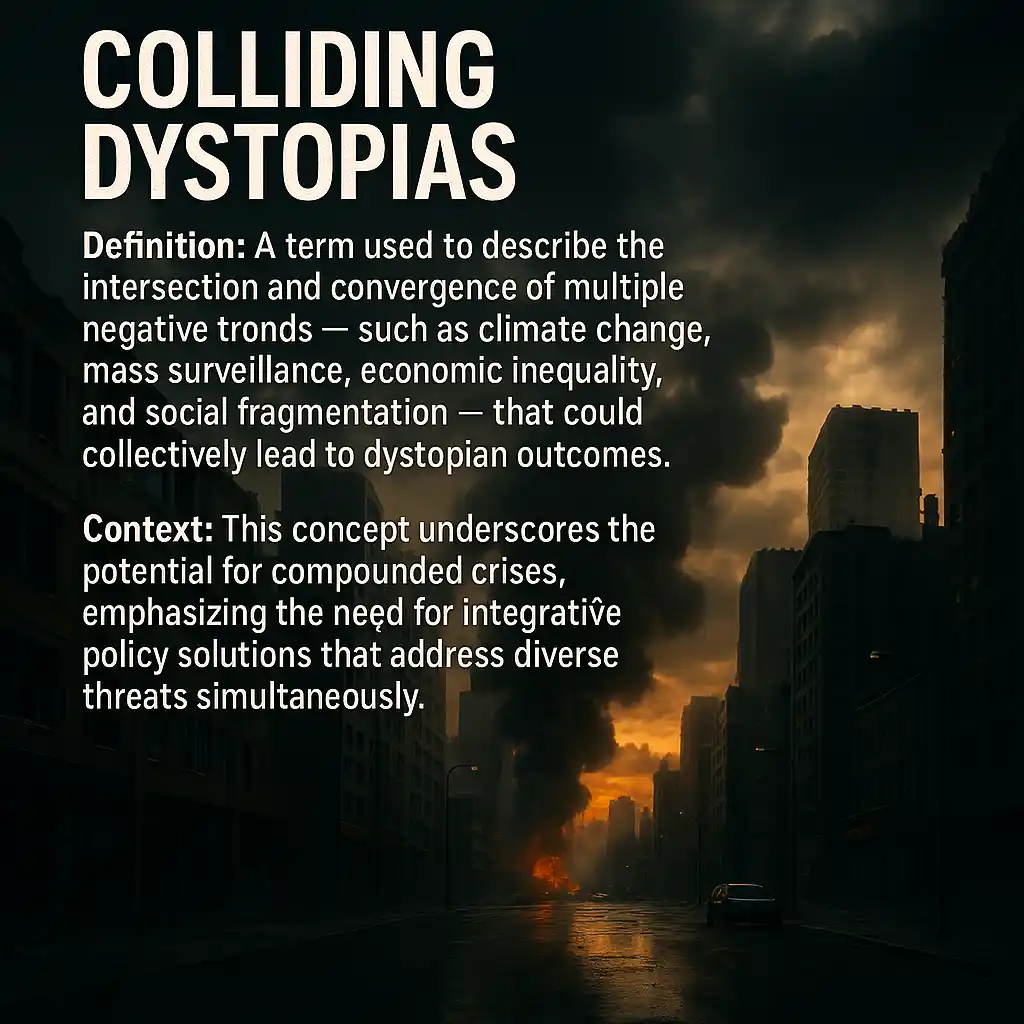
Colliding Dystopias
-
Definition: A term used to describe the intersection and convergence of multiple negative trends — such as climate change, mass surveillance, economic inequality, and social fragmentation — that could collectively lead to dystopian outcomes.
-
Context in Report: This concept underscores the potential for compounded crises, emphasizing the need for integrative policy solutions that address diverse threats simultaneously.
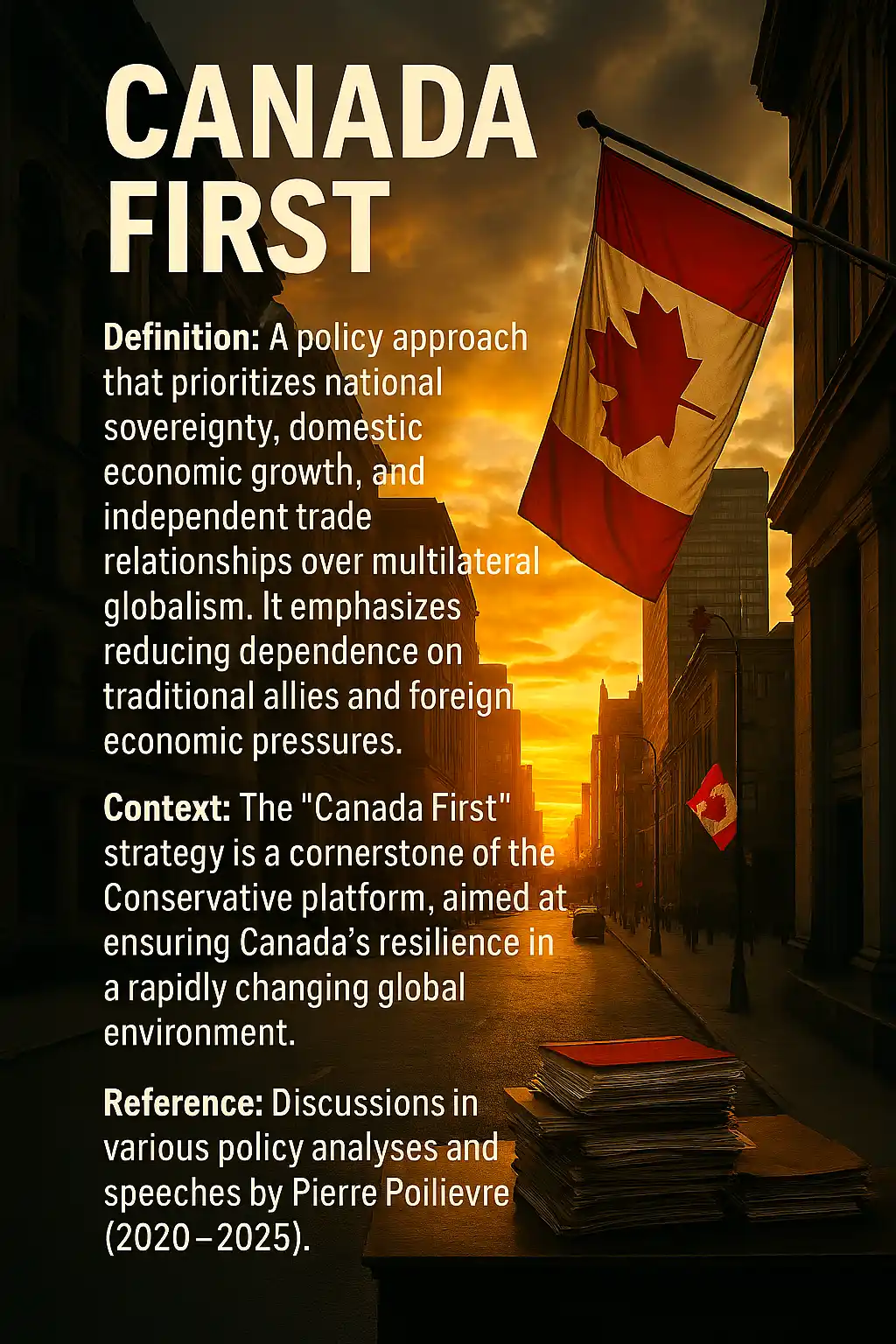
Canada First
-
Definition: A policy approach that prioritizes national sovereignty, domestic economic growth, and independent trade relationships over multilateral globalism. It emphasizes reducing dependence on traditional allies and foreign economic pressures.
-
Context in Report: The “Canada First” strategy is a cornerstone of the Conservative platform, aimed at ensuring Canada’s resilience in a rapidly changing global environment.
-
Reference: Discussions in various policy analyses and speeches by Pierre Poilievre (2020 – 2025).

Small Modular Reactors (SMRs)
-
Definition: Advanced nuclear reactors that are smaller in size and designed to be built modularly. They offer increased safety, lower initial capital investment, and the flexibility to be deployed in remote or decentralized locations.
-
Context in Report: SMRs are highlighted as a key element of the Conservative energy policy aimed at achieving energy independence and industrial competitiveness.
-
Reference: Industry reports and articles (e.g., Reuters.com) discussing modern nuclear technology and energy policy.
Blockchain Technology
-
Definition: A distributed ledger technology that allows for secure, transparent, and tamper-resistant record-keeping. It is the underlying technology behind cryptocurrencies and has applications in various sectors including finance, supply chain management, and governance.
-
Context in Report: Blockchain is mentioned as a strategic technology supported by the Conservative platform to modernize the Canadian financial sector and enhance digital innovation.
-
Reference: Various industry analyses and policy documents referenced in the report.

Cryptocurrency
-
Definition: Digital or virtual currencies that use crypto-graphic methods for secure financial transactions. Cryptocurrencies operate on blockchain technology and represent a new frontier in digital finance.
-
Context in Report: The regulation and promotion of cryptocurrency innovation is a component of the Conservative platform’s effort to position Canada as a leader in the digital economy.
-
Reference: Policy discussions in sources such as Policy Alternatives and Global News.

Fiscal Discipline
-
Definition: The practice of managing government finances in a way that avoids excessive deficits and debt accumulation, often through measures such as balanced budgets and controlled government spending.
-
Context in Report: Fiscal discipline is a central tenet of the Conservative economic strategy, aimed at ensuring long-term financial stability and resilience.
-
Reference: Economic analyses from Global News and Policy Magazine.
Related Content:
Title: “The Great Filter Ahead: Engineering a Pathway to Complex Civilizational Survival and Overcoming Cosmic Hurdles” https://skillsgaptrainer.com/the-great-filter-ahead-engineering-a-pathway/
Title: “Canada at a Crossroads in 2025: A Comprehensive Academic Examination of 20 Interconnected Crises” https://skillsgaptrainer.com/canada-at-a-crossroads-in-2025/
Title: “Ascension of the Chosen One: Embracing a Multidimensional Evolution Beyond Darkness” https://skillsgaptrainer.com/ascension-of-the-chosen-one/
Title: “Blueprint for Resilience: 27 Strategic Actions to Safeguard Humanity’s Future” https://skillsgaptrainer.com/blueprint-for-resilience/
Title: “Blue Storm Rising: The Quiet Force Within” https://skillsgaptrainer.com/blue-storm-rising/
Title: ““Blue Storm Rising” Master Report: A Comprehensive Framework for Alberta’s Industrial Miracle” https://skillsgaptrainer.com/blue-storm-rising-albertas-industrial-miracle/
Title: “Blue Storm Rising: A Canada-Wide Industrial Renaissance” https://skillsgaptrainer.com/blue-storm-rising-industrial-renaissance/
Title: “The Great Convergence: Humanity’s Metamorphosis Through Artificial Intelligence” https://skillsgaptrainer.com/great-convergence/
Title: “The Ghost in the Machine and the Spectre of Dystopia: Comparing Trans-humanist Visions in Eastern and Western Science Fiction” https://skillsgaptrainer.com/ghost-in-the-machine-spectre-of-dystopia/
Title: “Powering the Future: The Heroic Journey of Transcendent STEM Professionals in Age of Convergence” https://skillsgaptrainer.com/powering-the-future/
Title: “Navigating the Dystopian Singularity: Shaping TNG-Inspired Future Amidst Colliding Dystopias”https://skillsgaptrainer.com/navigating-the-dystopian-singularity/
To see our Donate Page, click https://skillsgaptrainer.com/donate
To see our YouTube Channel, click https://www.youtube.com/@skillsgaptrainer
